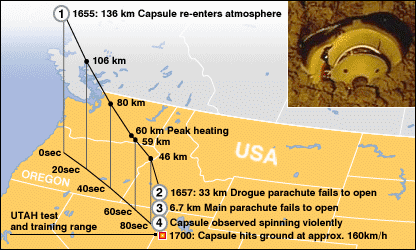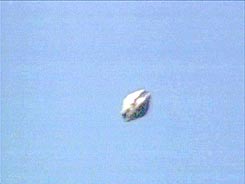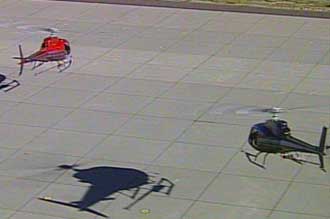Updates from 23:25
Avi Blizovsky
Direct link to this page: https://www.hayadan.org.il/gensisupt080904.html
Update 8/9/2004 time 23:10

The last moments of the spaceship Genesis
The space capsule crashed on Earth
A NASA space capsule carrying particles ejected from the sun crashed on its return to Earth in the Utah desert after the parachute failed to deploy.
The $264 million spacecraft spent two years in space collecting material from the Sun to help scientists better understand the origin of the Sun and the planets.
Pilots working as stuntmen in Hollywood waited to catch the capsule while it was still in the air to give the sensitive cargo a soft landing. NASA announced that it had formed a team to investigate what went wrong.
The officials said that it will take some time before it will be possible to know if how much, or if at all, the scientific data can be reproduced.
"We estimate that the capsule hit the ground at a speed of 310 km/h," said Chris Jones, director of solar system research at NASA's Jet Propulsion Laboratory in Pasadena, California.
Roy Haggard, who led the air rescue team, was one of the first to arrive at the crash site. He discovered the Genesis spaceship half buried in the ground.
The tool was slightly cracked - a few centimeters - due to the high impact speed, he said. According to him, it seems that the scientific equipment is also cracked.
The spacecraft ejected the container at 11:53 GMT (14:53 Israel time) at the correct speed and direction and the ejected part entered the atmosphere as planned at 15:54 Greenwich time (18:54 Israel time). The people in the control room clapped and cheered as the long-range cameras watched the 190-kilogram capsule in the upper atmosphere.
The capsule sped towards Earth, but the scientists expected to see it slow down due to the opening of side parachutes and even more slowed down with the opening of the main parachute. The joy turned to shock when they realized that the silver disc, as it appeared, was making its way towards a violent collision with the desert floor.
The capsule hit the ground around 16:00 PM (19:00 PM Israel time), a full 15 minutes before the time when it was supposed to fall from the sky in maneuvers controlled by the helicopter pilots.
"There are many serious things that could have happened and we probably received a long series of some of them. said project manager Don Sweetnam. "We still have hopes that the scientific part of the mission will yield results" he said optimistically.
The parachute did not open, and the particles from the solar wind were buried in the Utah desert
By Yuval Dror, Haaretz

The capsule falls into the Utah desert
The American Space Agency (NASA) recorded another painful failure yesterday (Wednesday). At 7 pm (Israel time) a capsule containing samples of atoms from the wind blowing from the sun crashed in the Utah desert. The capsule was supposed to be captured in the air by a pair of helicopters whose pilots trained for the mission for five years, but the parachutes that were supposed to slow its fall and allow its capture simply did not open. The box, weighing 205 kg, plunged to the ground and crashed. Last night it was still unclear what happened to the samples, but due to their great sensitivity - which necessitated the complicated seizure operation - they may have been damaged.
The research spacecraft "Genesis" was launched into space on August 8, 2001 with a clear goal: to return to Earth samples of charged atoms (ions) from the solar wind. To "collect" them, the mission spacecraft was launched to a distance of 1.5 million km from the Earth, to the region known as L1, where the Earth's gravity and the Sun's gravity cancel each other out.
After settling into the intended orbit, Genesis pulled out 55 hexagonal-shaped plates, made of a variety of pure materials, including zinc, aluminum, gold and diamond, and spread them out so that they were facing the solar wind. The ions were absorbed inside the special plates and kept in them in a state that did not change their basic properties. In the 850 days in which the plates were exposed to the solar wind, billions of ions were accumulated, the total weight of which does not exceed 20-10 millionths of a gram. In April 2004, the tablets were returned to a special capsule designed to keep them, and the return journey to Earth began.
Yesterday morning, the last phase of the mission, which cost more than 260 million dollars, began. The box separated from the spaceship - from which it was sent into a long orbit around the sun. This box, which is shaped like a "flying saucer" from science fiction movies, moves at a speed of 40 thousand km per hour. According to the plan, two and a half minutes after its release, at an altitude of about 33 km, the first parachute was supposed to open to slow the fall. Four more minutes later, at an altitude of 6.1 km, the main chute was supposed to open.
At this point, two helicopters were supposed to enter the picture, piloted by pilots specializing in special stunts in Hollywood films, who had been training for the operation for five years. At the bottom of the planes was mounted a special rod with a curved hook at the end, a kind of hook, with which the pilots were required to grab the parachute and thus capture the capsule, put it in a special container, gently land it and transfer it to a "clean room", where its software will be tested. The purpose of the aerial capture was to prevent a situation where the rare specimens would be damaged, as there was a fear of damage even if they fell to the ground at a relatively slow speed of 16 km/h.
But last night, as mentioned, the worst case scenario for NASA came true. When cameras spotted the capsule emerging from the clouds, applause was heard in the control room, but about two minutes later the helicopters in the air reported: "The parachutes didn't open, they didn't open!" A few seconds later the capsule hit the ground at a tremendous speed, and the control room was silent. "We'll collect some tools and go get her out of the ground," said the NASA people who were in the helicopters.
At this stage it is not clear what happened to the samples, and NASA hopes that they have not suffered any damage that would render them useless. With the help of the samples, the scientists hoped to decipher the exact composition of the sun. Although it is known to consist mostly of helium and hydrogen, studies of the solar wind in the early 70s found signs of more than 60 other components. The scientists intended to test the collected wind particles and based on the findings to map, for the first time, the exact composition of the sun - a mapping that could help them understand the origin of the solar system, and within it the earth. Last night's crash may have also dashed any hope of reaching that understanding soon.
First update, 8/9/2004 19:30 p.m
The Genesis spacecraft re-entering the atmosphere crashed in the Utah desert when attempts to trap it in mid-air to protect it from potential damage failed.
Senior NASA officials at NASA's Jet Propulsion Laboratory in California said that the cameras failed to locate the parachutes that were supposed to slow her fall.
Since there was no mechanism to slow the cell down, it hit the ground at a speed of 160 km/h.
Senior NASA officials located the spacecraft around 12 noon EST (19:00 local time) after it dug a hole in the desert soil.
"It is not yet possible to determine the extent of the damage caused to the spacecraft's systems.
The space capsule "Genesis" crashed in the USA
The capsule, which is about the size of an average refrigerator, stayed in space for about three years, gathering information about the solar system. On the way back to Earth, the parachute that was attached to it did not open and the capsule crashed to the ground
ynet (news agencies)
The Genesis space capsule, which was supposed to provide researchers with a lot of information about the solar system, crashed today (Wednesday) in the Utah desert in the United States.
According to the plan, a plane with stuntmen from Hollywood was supposed to catch the capsule when it returned to the atmosphere, after the parachute attached to it opened. But due to some malfunction, the parachute did not open and the capsule, containing dozens of particles collected in space, crashed.
It is still not clear if the particles, which were held in fragile disks, were destroyed, but NASA feared that even if the parachute was opened, the particles would be damaged. "We will remove what is there," said Roger Vince, from the Los Alamos laboratory, "it will be much more difficult to remove anything from the broken capsule."
The capsule, which is about the size of an average refrigerator, spent about three years in space as part of a project that was supposed to take six years, at a cost of 260 million dollars.
Prof. Alon Gani, from the Faculty of Aeronautics and Space Engineering at the Technion, explains that the capsule was on its way to the atmosphere with particles of the solar wind, and that these are tiny charged particles, mostly positive, that are emitted from the sun, that float at great speed and also reach the earth.
"The particles are interesting because they point to a possible origin of the solar system and the planets. According to the composition of the particles it is possible to learn something about the formation of the solar system. The sun is composed of hydrogen and helium, but the planets are composed of other elements."
(Since it is no longer relevant, the information about the solar particles collected by the spacecraft and the way in which the helicopters were supposed to capture them are in the preliminary news).

The helicopters are preparing to depart for the operation. Photograph from the NASA website
For news on the subject in CNN
https://www.hayadan.org.il/BuildaGate4/general2/data_card.php?Cat=~~~946581662~~~86&SiteName=hayadan
